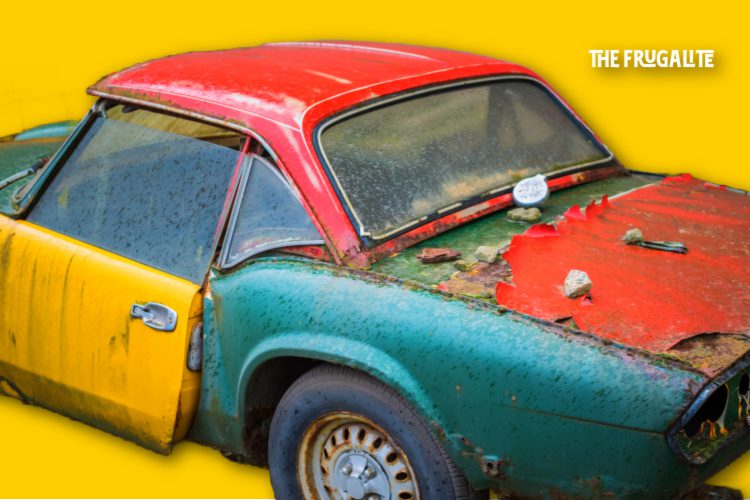(Psst: The FTC wants me to remind you that this website contains affiliate links. That means if you make a purchase from a link you click on, I might receive a small commission. This does not increase the price you’ll pay for that item nor does it decrease the awesomeness of the item. ~ Daisy)
By the author of the FREE online course Growing Self-Sufficiency: The Whole Picture
Being someone who makes a habit of driving older-model cars, whether it’s worthwhile to DIY bodywork has been a question of interest for me for more than a decade. When I lived in the city, I lived without a car.
Moving out to the country in 2013 meant that I bought my first used car. It was when that old Ford Focus developed some rust spots that I first began my journey into bodywork. In my own experience, I would answer the question of whether it is worth it to do the bodywork with a resounding “Yes!” but there are certain conditions and circumstances attached to that yes. So, read on Frugalite, to get the scoop on DIY bodywork for beginners and do-it-yourself-ers.
Do You Enjoy Learning Handy Skills?
I started without a clue, taking an old piece of sandpaper to the rust spots, which were, quite frankly, annoying me. I will never forget the first moment I took a piece of sandpaper to my car. It felt…somewhat taboo…like, “What am I doing? What is going to happen here?” Once I got past that feeling of “Hey…..I’m scraaaaaatching my own caaaaaarrrrrr!!!!” then the fun began.
I was curious, and I enjoyed the process of learning how to do something. Could I beat the rust? Would the rust come off? What would be beneath it? What kind of paint would work best? Over the years, I have seen my skill level develop to a high level of confidence. I now know what I need to tape off and what I don’t. I can feather in with a spray can and get a result that I’m satisfied with.
Do You Have Some Time Available for DIY Bodywork?
If you work a demanding job or jobs and have no time to spare, with young kids in the picture, for example, then this may not be the hobby for you. A number of years ago, I undertook a pretty massive project: I completely refinished a trailer made from the back end of a totalled Chevy S10.
I bought a sandblaster and taught myself how to sandblast the entire rusted tongue of the trailer and a few patches of rust on the body of the trailer. I bought a dolly and banged out as much of the dings as I could. What I couldn’t bang back into shape, I filled with fiberglass.
I then began the long process of completely sanding, priming, painting and clear coating the entire trailer (three coats of everything). This project took three months of my free time; every moment that I wasn’t working, I was working on that trailer. I have to say I was very proud of it. I enjoyed the work. I learned a lot and gained confidence in my skills. The trailer looked great. When I ended up selling it a number of years later, the guy wanted me to drop the price. I stood my ground, telling him what I had put into it. He agreed to pay the full amount, saying he respected what I had put into it.
Is Your Car Ummm…a Fixer Upper?
One of the things that allowed me to DIY bodywork on my vehicles was that, well, anything I did was probably going to make them look better, not worse. If you own a pretty new car and very expensive car, then this probably isn’t for you unless you want to invest in a lot of expensive equipment. I only used matched paint that I bought at the local hardware store or auto supply shop in a spray can. Even though I’m much better at it than I was in the beginning, you are not going to get the results of a pro body shop with a spray gun, etc.
Along with this, I undertook the bodywork with a sense of humor. I am not my car…my car doesn’t represent me. It isn’t going to be perfect, but I can likely improve it.
Are You Clear on Why You’re Doing DIY Bodywork?
I will undertake bodywork for different reasons on different vehicles. It can still be worth it. The trailer job I described above was a learning job and a pure labor of love. In addition, the trailer in its smashed-up version had already attracted some unwanted attention from the local police. I figured that if I polished it up a bit, it might fly “under the radar,” so to speak.
 With my Ford Focus, the rust was mainly non-structural, and I just wanted to keep the car looking nice. With my Nissan Sentra, the rocker panels were going. I wanted to run the car into the ground without attracting any undue attention, so I patched the rockers, repainted as best I could, and kept on going until she died (sob!).
With my Ford Focus, the rust was mainly non-structural, and I just wanted to keep the car looking nice. With my Nissan Sentra, the rocker panels were going. I wanted to run the car into the ground without attracting any undue attention, so I patched the rockers, repainted as best I could, and kept on going until she died (sob!).
With my most recent car, Lucky, I have been, well, incredibly lucky as there was no rust on the car when I bought it except for a couple of small non-structural spots on the back of the trunk. I was very, very busy, and money was tight. I didn’t want to spend on the products for the job, and the spots grew enormously over a couple of years. Yikes! Even if I have to buy the stuff on credit, I will never leave rust spots like that again.
Because I left the spots so long, one had rusted right through. It required fibreglassing inside and out. Even though I intentionally left a pretty thick cover of fiberglass on the two spots, I was thrilled with how it came out. Honestly, it just looks so much better than the bubbly rust. I know I can’t completely stop it, but the job will slow the rust down considerably. With the car otherwise in excellent shape, that job made sense to me to do. When I did the back of the trunk, I also touched up a scratch on the driver’s side door from a ding where the previous owner got dinged in a parking lot.
The cost? A custom spray bomb of matched paint from a local autobody shop, a small can of light fiberglass, one can of auto primer and one can of clearcoat cost me around $60. I already had a bunch of sandpaper for my palm sander on hand (it finally died on this job after ten years of faithful service!). To have these areas of my car painted by the pros would have easily been a few hundred dollars or more, especially these days.
For some, they might say, “Let it rust, and who cares!” Yes, I see your point. However, for me, this was the right choice.
DIY Bodywork: Not Just for the Pros
Doing DIY bodywork on your vehicle might be worth it in some cases. Could you see yourself trying bodywork for any of the reasons offered here? Do you have your own DIY bodywork story you can share with us? Please tell us in the comments section!
About Colette
Colette is passionate about sharing her knowledge of thrifty living and self-sufficiency. She has developed her skills in self-reliance living in the suburbs, the city, and more recently, on her own Half-Acre Homestead. Colette lived five years completely off-grid and without running water in an eight by 24 foot tiny home while designing and building her own 18 by 24-foot eco-cabin. Her website, Half Acre Homestead is attracting followers from around the world who want to become more self-sufficient. Colette invites you to stop by the Homestead and check out all of the great resources including the practical How To Guides, A Tiny Home Resource Center and her organic gardening stories on her blog. She shares her wholistic model (body/mind/spirit) for achieving self-sufficiency in her Free Course, “Growing Self-Sufficiency: The Whole Picture.” Stop by the Homestead today to register free of charge!











2 thoughts on “When Is It Worth It to DIY Bodywork on Your Car?”
I’m not much good at this but my husband did a lot of body work for us. A number of times I held a backing plate while he worked out dings and dents. We had a leak around the rear window of an older car. He purchased a new gasket, and we spent a very long time installing and adjusting. It was a tremendous relief when the leak was completely gone after our efforts.
Hi Mary, Good for you! Anyone who does bodywork would appreciate having a helper! Gaskets can be very finicky. I have never installed one, but have often had to “fiddle” with the ones in my older vehicles. Thank you for sharing your own stories of bodywork on your vehicles. Wishing you the best!